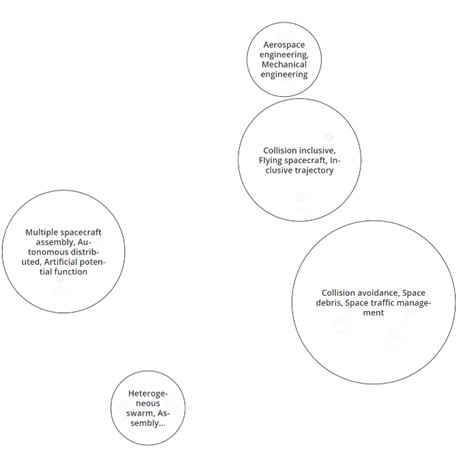The purpose of a literature review is to generate a state-of-the-art overview for a particular topic. This requires identifying the most relevant papers to the topic at hand and crafting a story about how the papers are related to one another. This can be a challenging endeavor without some way to strategize and organize the review.
As I have written literature reviews in graduate school, I have found several resources that have helped tremendously with identifying relevant papers and understanding how they are connected. In this article, I will share the tools that I use to write literature reviews.
Open Knowledge Maps
Open Knowledge Maps is designed as a visual search engine for research. Input terms generate a map, and the more key terms that are used the more refined the knowledge map becomes. For example, when I input ‘space traffic management’, it generated a knowledge graph spanning topics from air traffic controllers, to geography, to traffic classification algorithms (upper image). When I input a more specialized term like ‘autonomous spacecraft collision avoidance’ the knowledge map generated narrower results (lower figure). The relative size of each topic represents the number of papers that the knowledge map generator was able to find under that category. Each topic can be scrolled over to see which papers the website has identified as relevant.

Open Knowledge Maps output of search term ‘space traffic management.’

Open Knowledge Map output for search term ‘autonomous spacecraft collision avoidance.’
A caveat of Open Knowledge Maps is that it was designed with life sciences in mind, so it will not provide a comprehensive overview of topics related to various specialized topics within aerospace. However, if you are writing a literature review on a new topic, this tool can be a good start in illustrating how the topic you are studying is related to other sub-fields.
Inciteful
The purpose of Inciteful is to provide a visual representation of papers. It works by either inputting a single paper and seeing which papers are relevant, OR by inputting two papers and seeing a map of how the two are connected. It also allows a keyword filtering method to select papers that only discuss specific phrases. It has different portals to identify what or who is being represented by the graph; there is a widget with a breakdown of the journals featured in the graph, of the top authors, of recent papers, and the ranking of each paper by a similarity score to the paper of interest.
It is highly interactive, and papers of interest can be added to a literature review with a simple click. It also saves papers in bibtex form, which allows for easy integration between Inciteful and LaTex.

Example output from Inciteful.
Connected Papers
Connected Papers generates a map similar to Inciteful. The unique feature of Connected Papers is that it sorts works into prior and derivative works. For an input paper, prior works refers to the citations in the paper and derivative works refers to citations of the paper. It also shows the number of citations for each work in the map, and displays lines to papers that have cited one another. The darker colors on the graph represent more recent papers, and the lighter colors represent older papers.

Connected Papers output of the search term ‘tackling youth unemployment:evidence from the labor market experiment in Uganda.’
I discovered Connected Papers before Inciteful, so it is the tool that I am more familiar with using. Speaking from personal experience, Connected Papers has been a massively helpful resource in helping me to identify papers that I missed when reading other papers, or searching google scholar. It does not always produce the same results as Inciteful, so you can consider it another tool in in the literature review toolbox to help you construct the most complete overview possible of a. new research topic.
